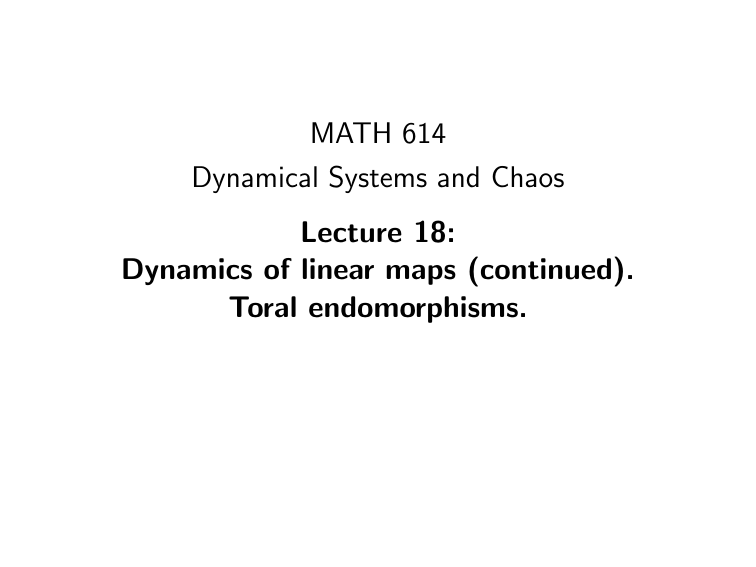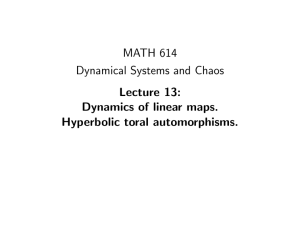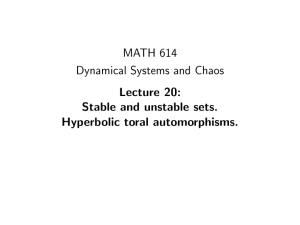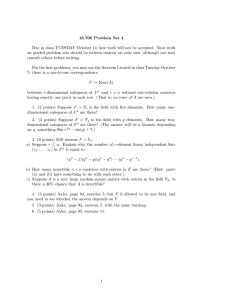MATH 614 Dynamical Systems and Chaos Lecture 18: Dynamics of linear maps (continued).
advertisement

MATH 614
Dynamical Systems and Chaos
Lecture 18:
Dynamics of linear maps (continued).
Toral endomorphisms.
Linear transformations
Any linear mapping L : Rn → Rn is represented as
multiplication of an n-dimensional column vector by
a n×n matrix: L(x) = Ax, where A = (aij )1≤i,j≤n.
Dynamics of linear transformations corresponding to
particular matrices is determined by eigenvalues and
the Jordan canonical form.
Stable and unstable subspaces
Proposition 1 Suppose that all eigenvalues of a linear map
L : Rn → Rn are less than 1 in absolute value. Then
Ln (x) → 0 as n → ∞ for all x ∈ Rn .
Proposition 2 Suppose that all eigenvalues of a linear map
L : Rn → Rn are greater than 1 in absolute value. Then
L−n (x) → 0 as n → ∞ for all x ∈ Rn .
Given a linear map L : Rn → Rn , let W s denote the set of all
vectors x ∈ Rn such that Ln (x) → 0 as n → ∞. In the case
L is invertible, let W u denote the set of all vectors x ∈ Rn
such that L−n (x) → 0 as n → ∞.
Proposition 3 W s and W u are vector subspaces of Rn that
are transversal: W s ∩ W u = {0}.
Definition. W s is called the stable subspace of the linear
map L. W u is called the unstable subspace of L.
Hyperbolic linear maps
Definition. A linear map L is called hyperbolic if
it is invertible and all eigenvalues of L are different
from 1 in absolute value.
Proposition Suppose L : Rn → Rn is a hyperbolic
linear map. Then
• W s ⊕ W u = Rn ;
• if x ∈
/ W s ∪ W u , then Ln (x) → ∞ as
n → ±∞.
Stable and unstable sets
Let f : X → X be a continuous map of a metric space (X , d ).
Definition. Two points x, y ∈ X are
forward asymptotic
with respect to f if d f n (x), f n (y ) → 0 as n → ∞.
The stable set of a point x ∈ X , denoted W s (x), is the set
of all points forward asymptotic to x.
Being forward asymptotic is an equivalence relation on X .
The stable sets are equivalence classes of this relation. In
particular, these sets form a partition of X .
In the case f is a homeomorphism, we say that two points
x, y ∈ X are backward
asymptotic with respect to f if
d f −n (x), f −n (y ) → 0 as n → ∞. The unstable set of a
point x ∈ X , denoted W u (x), is the set of all points
backward asymptotic to x. The unstable set W u (x) coincides
with the stable set of x relative to the inverse map f −1 .
Example
• Linear map L : Rn → Rn .
The stable and unstable sets of the origin, W s (0) and W u (0),
are transversal subspaces of the vector space Rn . For any
point p ∈ Rn , the stable and unstable sets are obtained from
W s (0) and W u (0) by a translation: W s (p) = p + W s (0),
W u (p) = p + W u (0).
Real projective plane
Real projective plane RP2 is obtained from the Euclidean
plane by adding points “at infinity”.
Formally, elements of RP2 are one-dimensional subspaces of
R3 (straight lines through the origin). The angle between
lines serves as a distance function. Topologically, RP2 is a
closed non-orientable surface.
Lines in the real projective plane correspond to 2-dimensional
subspaces of R3 . They are simple closed curves.
Points in the projective plane are given by their
homogeneous coordinates [x : y : z]. The Euclidean plane
R2 is embedded into RP2 via the map (x, y ) 7→ [x : y : 1].
Projective transformations
A projective transformation of RP2 is a self-map
that takes lines to lines. For any projective
transformation P there exists an invertible 3×3
matrix A = (aij ) such that
[x 0 : y 0 : z 0] = P([x : y : z]) if and only if
0
x
x
a11 a12 a13
0
y = r a21 a22 a23 y
z
a31 a32 a33
z0
for some scalar r 6= 0. The matrix A is unique up
to scaling. Dynamics of P is determined by
spectral properties of A.
Torus
The two-dimensional torus is a closed surface obtained by
gluing together opposite sides of a square by translation.
Torus
The two-dimensional torus is a closed surface obtained by
gluing together opposite sides of a square by translation.
Alternatively, the torus is defined as T2 = R2 /Z2 , the
quotient of the plane R2 by the integer lattice Z2 . To be
precise, we introduce a relation on R2 : x ∼ y if y − x ∈ Z2 .
This is an equivalence relation and T2 is the set of equivalence
classes. The plane R2 induces a distance function, a topology,
and a smooth structure on the torus T2 . Also, the addition is
well defined on T2 . We denote the equivalence class of a
point (x, y ) ∈ R2 by [x, y ].
Topologically, the torus T2 is the Cartesian product of two
circles: T2 = S 1 × S 1 .
Similarly, the n-dimensional torus is defined as Tn = Rn /Zn .
Topologically, it is the Cartesian product of n circles:
Tn = S 1 × · · · × S 1 .
Transformations of the torus
Let π : Rn → Tn be the natural projection,
π(x1 , . . . , xn ) = [x1 , . . . , xn ]. Suppose F : Rn → Rn is a
transformation such that x ∼ y =⇒ F (x) ∼ F (y) for all
x, y ∈ Rn . Then it gives rise to a unique transformation
f : Tn → Tn satisfying f ◦ π = π ◦ F :
Rn
πy
Tn
F
−→
f
−→
Rn
yπ
Tn
The map f is continuous (resp., smooth) if so is F .
Examples. • Translation (or rotation).
F (x) = x + x0 , where x0 ∈ Rn is a constant vector.
• Toral endomorphism.
F (x) = Ax, where A is an n×n matrix with integer entries.
Translations of the torus
For any vector v ∈ Rn and a point of the n-dimensional torus
x ∈ Tn , the sum x + v is a well-defined element of Tn .
Given v ∈ Rn , let Tv (x) = x + v be the translation of the
torus Tn .
Theorem 1 Let v = (v1 , v2 , . . . , vn ). The linear flow Ttv ,
t ∈ R is minimal (all orbits are dense) if and only if the real
numbers v1 , v2 , . . . , vn are linearly independent over Q.
That is, if r1 v1 + · · · + rn vn = 0 implies r1 = · · · = rn = 0
for all r1 , . . . , rn ∈ Q.
Theorem 2 Let v = (v1 , v2 , . . . , vn ). The translation Tv is
minimal (all orbits are dense) if and only if the real numbers
1, v1 , v2 , . . . , vn are linearly independent over Q.
Toral automorphisms
Example. F (x) = Ax, where A =
1 1
.
0 1
Hyperbolic toral automorphisms
Suppose A is an n×n matrix with integer entries. Let LA
denote a toral endomorphism induced by the linear map
L(x) = Ax, x ∈ Rn . The map LA is a toral automorphism if
it is invertible.
Proposition The following conditions are equivalent:
• LA is a toral automorphism,
• A is invertible and A−1 has integer entries,
• det A = ±1.
Definition. A toral automorphism LA is hyperbolic if the
matrix A has no eigenvalues of absolute value 1.
Theorem Every hyperbolic toral automorphism is chaotic.
Cat map
Example. LA , where A =
2 1
1 1
=
1 1
0 1
1 0
.
1 1
Stable and unstable subspaces project to dense curves on the
torus.







